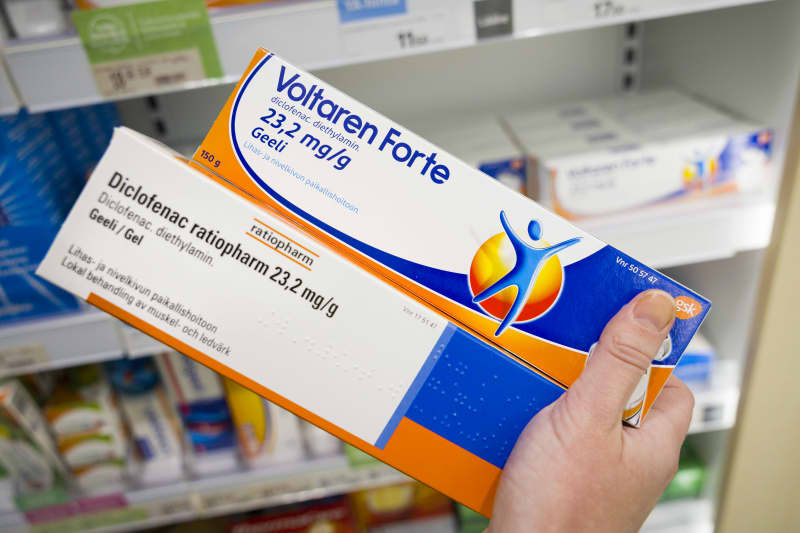
According to the Finnish Pharmacists’ Association, there will be no change in the way diclofenac-containing painkillers are sold in Finland, at least for the time being. Interest in the environmental impact of medicines is also growing in Finland.
In Swedish pharmacies, painkiller gels containing diclofenac will from now on be sold behind the counter instead of on the open shelf.
The customer must therefore ask the pharmacy staff for the product, and at the time of purchase, the customer will receive information on the use of the pain gel and its environmental impact. When the product is sold online, the person ordering the product must confirm that they have read the instructions.
In Finland, pharmacies are not changing the way they sell the popular pain relievers, at least for the time being.
However, the Finnish Pharmacists’ Association has been keeping a close eye on the long-standing debate in Sweden about pain gels containing diclofenac.
– If the need arises, of course we in Finnish pharmacies want to act responsibly and we are also ready to take them behind the counter so that the customer can always get advice when buying medicine, Charlotta Sandler says.
Kipugel should not be used for too long
According to the Apteekkariliitto, diclofenac is sold as a self-medication in Finland under four different trade names: Diclofenac Ratiopharm, Diclospray, Voltaren Emulgel and Voltaren Forte.
Yle Uutiset could not reach Haleon’s representative to comment on the matter before the publication of this story.
Charlotta Sandler from Apteekkariliito considers it important that pain gels are not used unnecessarily. For example, if the problem is prolonged, it should be discussed with a pharmacist or doctor about treatment methods.
– Pain gels are only temporary pain relievers. They are basically not intended for long-term use, Charlotta Sandler says.
Diclofenac is harmful to aquatic organisms
Diclofenac, which has been moved behind the counter in Sweden, is a drug whose environmental effects have been extensively studied.
– In water works, diclofenac is a very toxic substance. It can cause harm to a wide range of aquatic organisms – including fish and mussels and other invertebrates. Depending on the concentration, milder or more serious harm, says Elli Leppä.
In high concentrations, diclofenac can affect, for example, the development of fish fry and interfere with the reproduction and growth of mussels. Lower concentrations can cause, among other things, changes in the fish’s organs.
– Even in Finland, diclofenac has sometimes been detected in natural waters in concentrations that could possibly cause changes in the kidneys of fish, for example, Sanja Riikonen states.
Diclofenac ends up in waterways, for example with washing water. It is a troublesome substance in waste water.
– The cleaning methods currently used at wastewater treatment plants are hardly able to remove diclofenac during the process, Sanja Riikonen states.
In the EU, diclofenac is currently a candidate for the list of priority substances, to which the concentrations of the substances in water bodies are monitored.
Increasing consumer interest in the environmental impact of medicines

Consumers’ interest in the environmental effects of medicines has grown in recent years, and it has also been noticed in Finnish pharmacies.
– Interest in environmental effects is growing. And in Sweden, we see that consumers even make choices based on that when there is an alternative treatment, says Charlotta Sandler from Apteekkariliito.
Charlotta Sandler considers it important that attention is paid to the environmental effects of medicines. Still, he emphasizes that when choosing a treatment, you must follow medical principles and follow the doctor’s instructions.
In some cases, medicines with different environmental effects can be chosen, in some cases there are no alternatives or they are not suitable for the patient, also states Elli Leppä from Pharmaca.
– There may be situations when medicinal substances with a lot of environmental effects may be the only option for treating a certain patient. Then they should be used despite the fact that these effects have been observed.
Returning unused medicines is easy for the environment
Pharmaca published the environmental classification of domestic medicines for healthcare professionals more than a year ago. Pharmaca is planning to later make a clear version of the environmental classification for use by consumers as well.
– The environmental classification mainly talks about the effects on water bodies. For example, in practice, there is not really enough information available on the global scale yet, Elli Leppä from Pharmacasta says.
Most of the environmental effects of medicines come from properly used medicines that end up in sewage water after passing through the user’s body or directly from the user’s skin.
However, Elli Leppä also reminds us of a very easy way that everyone can reduce the environmental burden caused by medicines.
– If the consumer has unused or expired medicines, the basic instruction is that they must be returned to the pharmacy. It is being done well in Finland at the moment.
